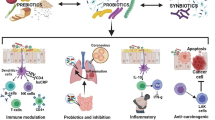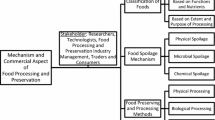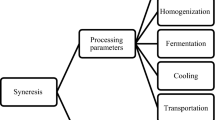Abstract
Eight commercial milk protein preparations of whey protein or casein enzymatic hydrolysates were investigated for migration and proliferation activities in a cell model for wound healing using rat intestinal epithelial cells of normal origin. Two casein-based preparations were very potent stimulators of migration, showing an increase of approximately 50% in concentrations below 1 µg/mL of solubilized milk powder. One of these preparations also stimulated cell proliferation in low concentrations, while the highest level of proliferation was obtained by a third casein-based hydrolysate showing a nearly 50% increase at 1 mg/mL. These results suggest that hydrolysis of casein may be important to obtain functional bioactives in intestinal cell recovery from damage or injury. As migration and proliferation are distinct mechanisms of importance for the integrity of the epithelial surface, both at normal conditions and especially after intestinal injury, these milk protein preparations could be used in functional foods for gut protection and recovery after injury.


Similar content being viewed by others
References
Ananthakrishnan AN (2015) Epidemiology and risk factors for IBD. Nat Rev Gastroenterol Hepatol 12:205–217
Andújar I, Ríos JL, Giner RM, Recio MC (2013) Shikonin promotes intestinal wound healing in vitro via induction of TGF-β release in IEC-18 cells. Eur J Pharm Sci 49:637–641
Arber N, Levin B (2005) Chemoprevention of colorectal cancer: ready for routine use? Curr Top Med Chem 5:517–525
Ardizzone S, Porro GB (2005) Biologic therapy for inflammatory bowel disease. Drugs 65:2253–2286
Baumgart DC, Vierziger K, Sturm A, Wiedenmann B, Dignass AU (2005) Mesalamine promotes intestinal epithelial wound healing in vitro through a TGF-beta-independent mechanism. Scand J Gastroenterol 40:958–964
Burisch J, Jess T, Martinato M, Lakatos PL, EpiCom E (2013) The burden of inflammatory bowel disease in Europe. J Crohns Colitis 7:322–337
Castro GA, Carvalho JE, Tinti SV, Possenti A, Sgarbieri VC (2010) Anti-ulcerogenic effect of a whey protein isolate and collagen hydrolysates against ethanol ulcerative lesions on oral administration to rats. J Med Food 13:83–90
Chatterton DEW, Nguyen DN, Bering SB, Sangild PT (2013) Anti-inflammatory mechanisms of bioactive milk proteins in the intestine of newborns. Int J Biochem Cell Biol 45:1730–1747
Clare DA, Swaisgood HE (2000) Bioactive milk peptides: a prospectus. J Dairy Sci 83(6):1187–1195
Coskun M, Vermeire S, Nielsen OH (2017) Novel targeted therapies for inflammatory bowel disease. Trends Pharmacol Sci 38:127–142
Dignass AU (2001) Mechanisms and modulation of intestinal epithelial repair. Inflamm Bowel Dis 7:68–77
FitzGerald AJ, Rai PS, Marchbank T, Taylor GW, Ghosh S, Ritz BW, Playford RJ (2005) Reparative properties of a commercial fish protein hydrolysate preparation. Gastroenterol 128:A219–A220
Grosvenor CE, Picciano MF, Baumrucker CR (1993) Hormones and growth factors in milk. Endocr Rev 14:710–728
Hansen B (1989) Determination of Nitrogen as elementary-n, an alternative to Kjeldahl. Acta Agric Scand 39:113–118
Jowett SL, Seal CJ, Phillips E, Gregory W, Barton JR, Welfare MR (2004) Dietary beliefs of people with ulcerative colitis and their effect on relapse and nutrient intake. Clin Nutr 23:161–170
Kanwar JR et al (2009) Molecular and biotechnological advances in milk proteins in relation to human health. Curr Protein Pept Sci 10:308–338
Kaplan GG (2015) The global burden of IBD: from 2015 to 2025. Nat Rev Gastroenterol Hepatol 12:720–727
Karrasch T, Jobin C (2009) Wound healing responses at the gastrointestinal epithelium: a close look at novel regulatory factors and investigative approaches. Z Gastroenterol 47:1221–1229
Koldovsky O (1996) The potential physiological significance of milk-borne hormonally active substances for the neonate. J Mammary Gland Biol Neoplasia 1:317–323
Larsen LB, Rasmussen MD, Bjerring M, Nielsen JH (2004) Proteases and protein degradation in milk from cows infected with Streptococcus uberis. Int Dairy J 14:899–907
McCormack SA, Viar MJ, Johnson LR (1992) Migration of Iec-6 cells—a model for mucosal healing. Am J Physiol 263:G426–G435
Melgar S, Shanahan F (2010) Inflammatory bowel disease-from mechanisms to treatment strategies. Autoimmunity 43:463–477
Mezzaroba LFH, Carvalho JE, Ponezi AN, Antonio MA, Monteiro KM, Possenti A, Sgarbieri VC (2006) Antiulcerative properties of bovine alpha-lactalbumin. Int Dairy J 16:1005–1012
Moura CS, Lollo PCB, Morato PN, Risso EM, Amaya-Farfan J (2017) Bioactivity of food peptides: biological response of rats to bovine milk whey peptides following acute exercise. Food Nutr Res 61:1290740
Neurath MF, Travis SPL (2012) Mucosal healing in inflammatory bowel diseases: a systematic review. Gut 61:1619–1635
Nielsen DSG, Theil PK, Larsen LB, Purup S (2012) Effect of milk hydrolysates on inflammation markers and drug-induced transcriptional alterations in cell-based models. J Anim Sci 90:403–405
Nielsen SD, Beverly RL, Qu Y, Dallas DC (2017a) Milk bioactive peptide database: a comprehensive database of milk protein-derived bioactive peptides and novel visualization. Food Chem 232:673–682
Nielsen SD et al (2017b) Correlation between sensory properties and peptides derived from hydrolysed-lactose UHT milk during storage. Int Dairy J 68:23–31
Ostergaard MV et al (2014) Modulation of intestinal inflammation by minimal enteral nutrition with amniotic fluid in preterm pigs. J Parenter Enter Nutr 38:576–586
Pihlanto-Leppala A (2000) Bioactive peptides derived from bovine whey proteins: opioid and ace-inhibitory peptides. Trends Food Sci Technol 11:347–356
Playford RJ, Macdonald CE, Johnson WS (2000) Colostrum and milk-derived peptide growth factors for the treatment of gastrointestinal disorders. Am J Clin Nutr 72:5–14
Purup S, Vestergaard M, Pedersen LO, Sejrsen K (2007) Biological activity of bovine milk on proliferation of human intestinal cells. J Dairy Res 74:58–65
Purup S, Larsen E, Christensen LP (2009) Differential effects of falcarinol and related aliphatic C-17-polyacetylenes on intestinal cell proliferation. J Agric Food Chem 57:8290–8296
Ray RM, McCormack SA, Covington C, Viar MJ, Zheng Y, Johnson LR (2003) The requirement for polyamines for intestinal epithelial cell migration is mediated through Rac1. J Biol Chem 278:13039–13046
Rayner TE et al (2000) Mitogenic whey extract stimulates wound repair activity in vitro and promotes healing of rat incisional wounds. Am J Physiol-Regul Integr Comp Physiol 278:R1651–R1660
Shah NP (2000) Effects of milk-derived bioactives: an overview. Br J Nutr 84:S3–S10
Silva SV, Malcata FX (2005) Caseins as source of bioactive peptides. Int Dairy J 15:1–15
Smacchi E, Gobbetti M (2000) Bioactive peptides in dairy products: synthesis and interaction with proteolytic enzymes. Food Microbiol 17(2):129–141
Xu RJ (1998) Bioactive peptides in milk and their biological and health implications. Food Rev Int 14:1–16
Acknowledgements
The authors thank Anette K. Nielsen, Kasper B. Poulsen, Hanne S. Møller and Stina G. Handberg for their skilled technical assistance. This research was supported by the Danish Council for Strategic Research (Project No. 3304-FSE-06-0508-02) and the Danish Agency for Science, Technology and Innovation.
Author information
Authors and Affiliations
Corresponding author
Ethics declarations
Conflict of interest
The authors declare that they have no conflict of interest.
Research Involving Human and Animal Participants
This article does not contain studies with human or animal subjects.
Rights and permissions
About this article
Cite this article
Purup, S., Nielsen, S.D., Le, T.T. et al. Wound Healing Properties of Commercial Milk Hydrolysates in Intestinal Cells. Int J Pept Res Ther 25, 483–491 (2019). https://doi.org/10.1007/s10989-018-9692-y
Accepted:
Published:
Issue Date:
DOI: https://doi.org/10.1007/s10989-018-9692-y




